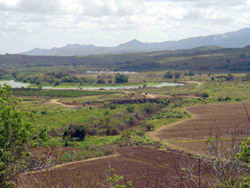
TUSCALOOSA, Ala. – Secrets hidden in the archaeological remains of a 16th century Indian town within Cuba are poised for revelation during an upcoming University of Alabama/Cuban joint expedition, the first collaboration of its kind between the U.S. and the island’s researchers.
Students nationwide may apply to participate in the 10-week excavation of portions of a former Arawakan Indian town in south-central Cuba. The multi-institution effort, led by UA in conjunction with the Provincial Center of Cultural Patrimony of Cienfuegos, Cuba, begins Jan. 17. It centers around the excavation of earthen mounds occupied by the Arawakan Indians at the time of the Spanish conquest of the island.
“Over the years, Cuban specialists have collaborated with other nations, on occasion, but it is highly unusual for U.S. and Cuban institutions to partner in this way,” said Dr. Vernon James “Jim” Knight, professor of anthropology at The University of Alabama and co-investigator of the project, along with the Provincial Center’s Marcos E. Rodríguez Matamoros and Mississippi State University’s John W. O’Hear.
Ten U.S. students will be selected to participate in a field school, held in conjunction with the archaeological expedition, where they will earn 15 hours of credit in anthropology. They will work hand-in-hand with Cuban students of anthropology. For more information, including an on-line application for the program, see the UA Web site http://cubafieldschool.ua.edu.
The excavation will advance a 1980s effort — which began as a joint Cuban-Soviet project but ended with the dismantling of the Soviet Union — at the archaeological site of Loma del Convento. On this site, located on a high hill overlooking the lower Arimao River Valley near Cienfuegos, Cuba, are nine earthen mounds surrounding an open area. The mounds were probably the locations of residences. It is one the few sites in Cuba that have yielded evidence of early 16th century Spanish contact.
Those who originally constructed the mounds were of a similar level of sophistication, although quite different culturally, as those who constructed the mounds at Moundville, some 13 miles south of Tuscaloosa and which Knight has studied for more than 30 years.
“They were chiefdoms, as were the inhabitants of Moundville,” Knight said. “And they were agriculturalists, but they grew root crops instead of corn.”
Chiefdom is the name given to societies of the period that were headed by a chief, a person with unusual ritual, political or entrepreneurial skills. The societies were very hierarchical, with power concentrated among kin leaders, who would redistribute resources to others. The effort presents researchers with an opportunity to fill a void in knowledge about the Arawakans, Knight said.

Another key aspect of the project is an attempt to learn more about a Catholic priest of the period, Bartolomé de las Casas. Although Las Casas remains relatively unknown in the United States, Knight said in Latin American countries the priest is a famous historical figure and is recognized widely as the first human rights advocate in the Western Hemisphere.
Historic documents identify the planned excavation site, Loma del Convento, as the Indian town Canarreo. In 1514 this town was granted to Las Casas, for his service during the Spanish conquest of the island. As practiced by the Spaniards of the period, when these towns were commended to individuals, the residents were not technically enslaved, but in reality they were treated as slaves, Knight said.
Las Casas, who became known as the “Protector of the Indians,” would later renounce this grant of Indian labor and begin a personal crusade on behalf of the Indians. This was unheard of at the time, Knight said.
“That was like giving away your livelihood,” the UA anthropologist said. “It was the point in his career when he said, ‘enough is enough.’ To find traces of that person, on the ground, is a big part of this,” Knight said of the project.
Knight said strained relations between the U.S. and Cuban governments, and the resulting travel restrictions, are minor issues in relation to the joint effort between the two country’s researchers. In 2002 the University received an academic license from the U.S. Department of the Treasury which permits travel to Cuba for the purpose of educational development.
“It encourages the kind of work that we’re doing,” Knight said of the license. “The only politics we’re interested in is 16th century politics. It’s all about archaeology and history.”
Additional representatives serving in a faculty role for the field school include, Lester Putonet Toledo, Provincial Museum of Cienfuegos; Dr. John E. Worth, University of Florida; Dr. Lee A. Newsom, Penn State University and a MacArthur Fellow; Dr. Kathryn S. Oths, The University of Alabama; Angela Lockard Reed, graduate student, University of Pittsburgh; and Ashley Brooke Persons, graduate student, The University of Alabama.
Contact
Chris Bryant, Assistant Director of Media Relations, 205/348-8323, cbryant@ur.ua.edu
Source
Dr. Vernon James "Jim" Knight, 205/348-5947, vknight@tenhoor.as.ua.edu